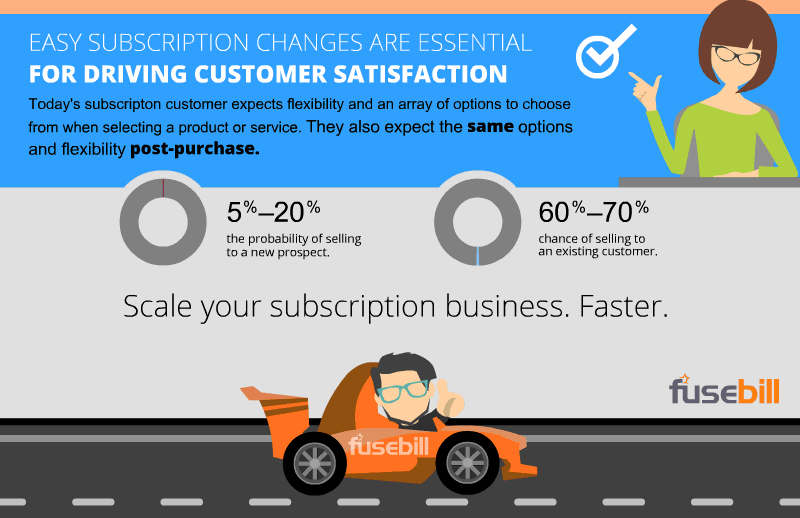As a subscription business leader, you’ve put in the work. You’ve built a great product, brought together a talented team, and marketed your subscriptions effectively.
The good news: It’s working! Customers are subscribing in droves.
The bad news: It’s more successful than you anticipated. Or, perhaps you didn’t realize the demand so many signups would place on your resources. The bottom line is, your team is spending a lot of time—probably too much time—manually activating and managing customer accounts.
If team members have to connect each customer individually to their desired subscription, the number of subscriptions that can be activated in a day is limited by the number of resources doing the activating.
And when you factor in updating customer information and payment methods, handling upgrades (and maybe a few downgrades), and the resulting action required of your finance team to ensure accurate bookkeeping and revenue recognition compliance, manual subscription management quickly becomes unscalable.
The solution? A digital transformation that puts more power in your customers’ hands with a self-service portal integrated directly into your automated recurring billing software. This can make subscription activation as easy as clicking a button. And after that, customers retain as much control of their account as your business permits.
Here are four impactful ways a subscription management system with a self-service portal can benefit your recurring revenue generation and business.
1. Collecting and Maintaining Accurate Billing and Account Data
Many subscription business sign-ups today involve an initial form for contact/billing information and password creation. However, just as many of these businesses work manually with new customers to create contracts and accounts by hand, tracking and managing data in spreadsheets.
However, once an account is created, what happens when customer details change? If your customers have to call, chat, or email in to have someone manually update their information and account preferences, it creates strain for everyone.
A self-service portal relieves this strain. And because it’s integrated with your subscription billing software, by extension, it can also be integrated with the technology stack touch-points through your business.
A self-service portal like the one above allows customers to create and update their own subscription information without reaching out to support for assistance. This information is then automatically updated on the back end across all departments. This way, every department has the most accurate and up-to-date customer data available.
2. Automating Dunning Management.
Involuntary churn can kill your business. Expired credit cards, hard and soft declines, and out-of-date billing information can all lead to failed payments that can ultimately mean lost customers.
For many subscription businesses, preventable, involuntary churn eats away at revenue while their team members are busy scrambling to manage new and active accounts manually.
The solution here is automated dunning management. When customers’ cards are approaching their expiry date, automated emails can direct them to the self-service portal to perform payment method updates, preventatively avoiding payment failures.
Customers can also access the portal at any time to enter new card information if their preferred payment method has changed.
Looking for a few other ways to enhance your dunning management? If you choose to implement a self-service portal provided by an agile subscription billing platform like Stax Bill, automatic retries can also help overcome soft declines. And when connected with the right payment gateway, credit card updates can be performed automatically without the need for any human intervention.
All of this creates a much more seamless customer experience, which increases customer satisfaction and ultimately retention.
3. Enabling Customers to Enhance and Upgrade Their Subscriptions
Another benefit of self-service portals is that customers can upgrade or downgrade their subscriptions on their own. Businesses can also elect to give customers the power to pause or cancel their subscriptions if they choose.
This does more than just relieve pressure on team members who would normally handle these changes manually. If it can work for your business, putting the power of upgrading in customers’ hands removes barriers that otherwise impede revenue growth. For example, expansion MRR is a type of monthly recurring revenue that can reverse the effects of churn, and it relies on subscription add-ons and upgrades.

Business automation vastly improves customer experiences. A customer is more likely to upgrade if they can do so with a few clicks than if they have to make a phone call or send an email. Unlocking expansion MRR and retention is as simple as giving customers more control.
4. Reducing Strain on Your Staff and Subscription Management System
Amid the benefits of accurate data, dunning management, and easier add-ons and upgrades, a common thread exists: time saved for your team.
The mission of subscription businesses isn’t to manage subscriptions; it’s to provide a product or service. When your team gets bogged down manually inputting and updating data, that mission can get lost in the shuffle.
Using a self-service portal for customers reduces the manual workload. It frees team members up to focus on the business’ core objectives and reduces barriers to growth and scalability.
Also Check this: What Kinds of Businesses Need Standalone Software for Subscription Management?
Self-service Portals are a Necessity in a Subscription Management System
As self-service checkout becomes more common in grocery and retail stores, so too will self-service portals in subscription businesses. We already see these portals in some of the most successful software as a service (SaaS) businesses like Slack, Shopify, and SurveyMonkey. It makes sense that smaller businesses with big scaling goals will follow their lead.
Giving up control is scary. For SaaS and other subscription businesses with their own development teams, it might make sense to build a self-service portal in-house. However, this can be an incredibly time-consuming process.
For businesses that want to save their teams time and effort, it can be a lot easier and more cost-efficient to use a white label, self-service portal, and billing platform like Stax Bill that integrates with existing business software.
With options to give customers as much or as little ability to change account information as desired, highly customizable recurring billing platforms like these give businesses and their customers a balance of control that works for everyone.
Customer expectations have changed and there’s a premium placed on the user experience. Fewer users are willing to take time to contact support for every little hiccup, preferring instead to read FAQs, search online, or otherwise solve problems on their own.
A self-service portal offers them this autonomy. It enables customers to take matters into their own hands 24/7 while simultaneously freeing up time and unlocking revenue opportunities for your subscription business.








